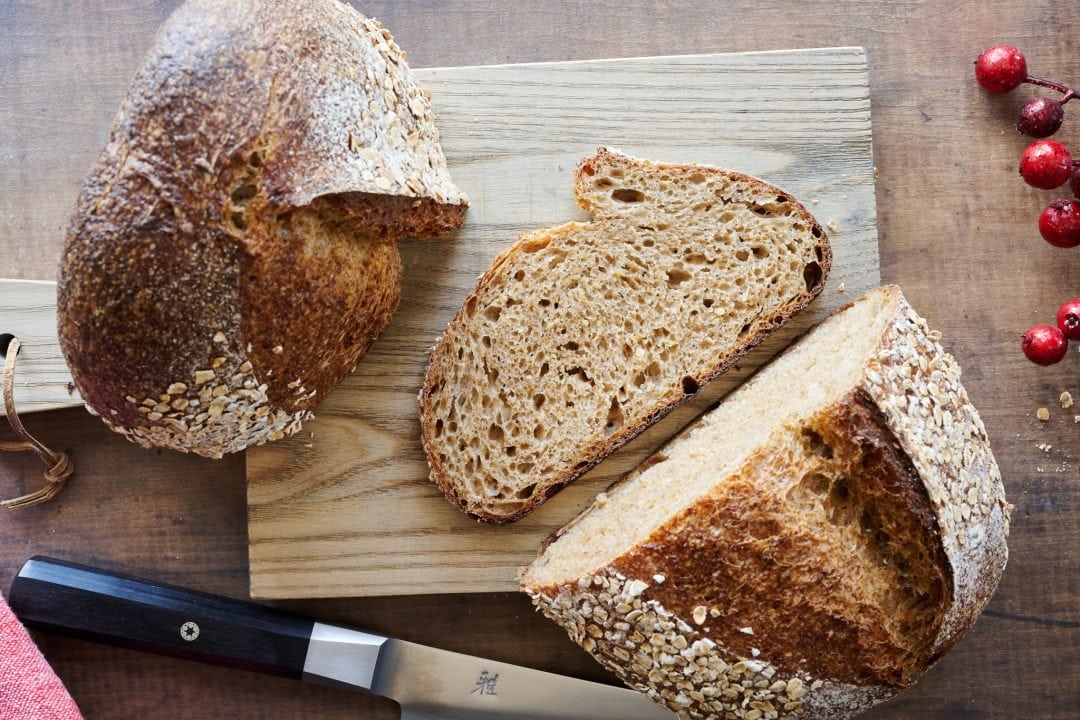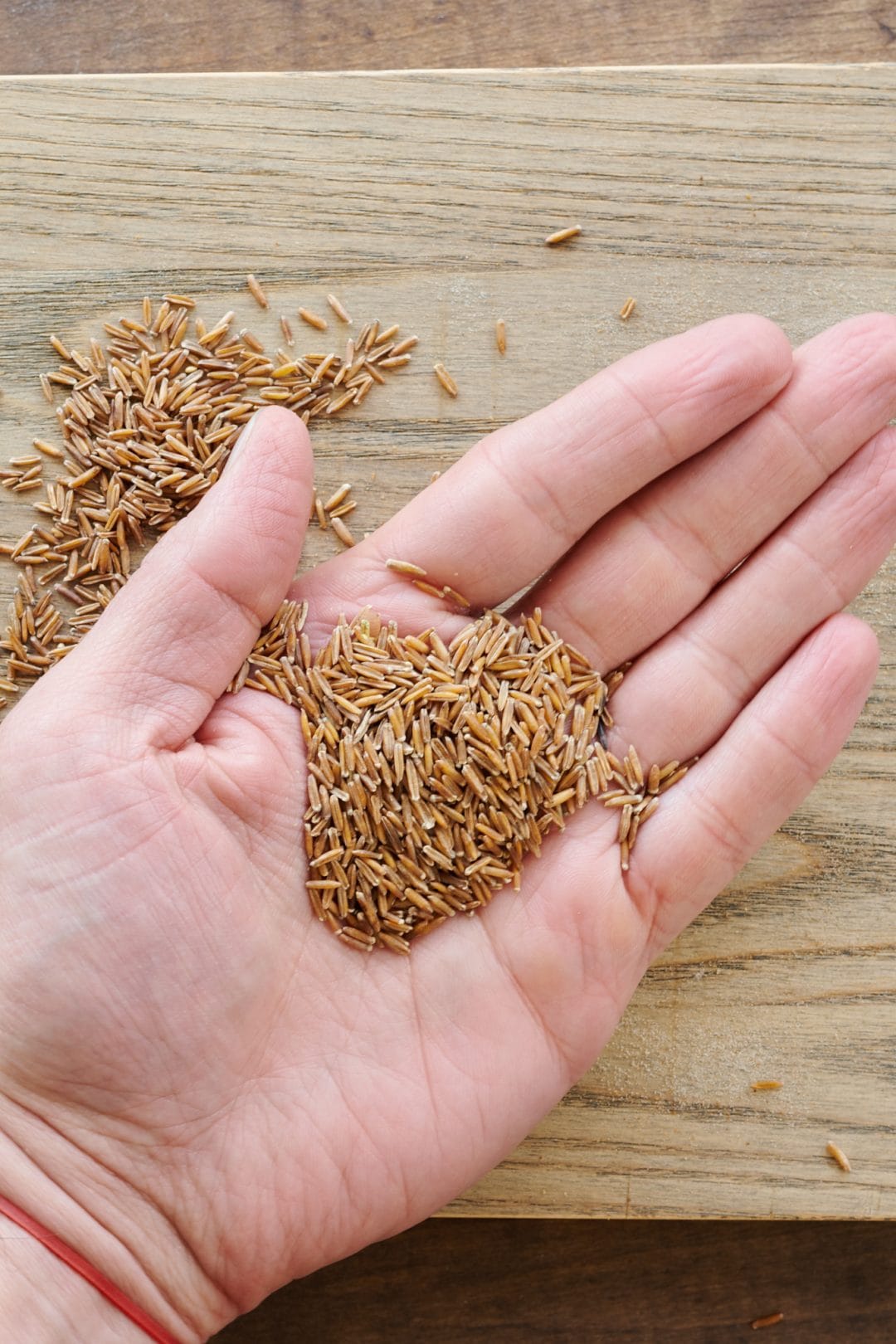When baking sourdough bread, bakers often become hyper-focused solely on the bread-making process, overlooking the provenance of the flour we’re working with. And as bakers, we actually come in pretty late in the game when considering the journey from seed to loaf. It’s a relatively small part to play compared to the researchers and breeders making grain available; the farmers cultivating their land, enriching their soil, growing, harvesting, and cleaning the grain; and finally, if not milling ourselves, the miller milling it into flour.
But every once in a while, a new grain, cereal, or in this case, wheatgrass, comes along that makes us step back and reexamine the entire chain—and Kernza did precisely that.
This relatively new perennial wheatgrass has grown in popularity thanks to its nutritional benefits, unique flavor profile, and environmental sustainability. But perhaps equally important for us sourdough bread bakers, it has a unique flavor profile that’s deliciously nutty and slightly sweet. Using it makes for one heck of a loaf of bread.
In this recipe, I leverage Eric Pallant’s research on Kernza and freshly mill this wheatgrass with my home grain mill and use the flour in combination with wheat to produce a delicious loaf of Kernza sourdough bread that’s as healthy as delectable.
Real quick, why should I bake with Kernza?
- Kernza is a sustainable crop: It supports an agricultural practice that improves soil health.
- Unique flavor: Kernza adds a delicious nutty and sweet flavor to bread.
- Increased nutrition compared to modern wheat: Whole-grain Kernza has higher protein, fiber, and minerals.
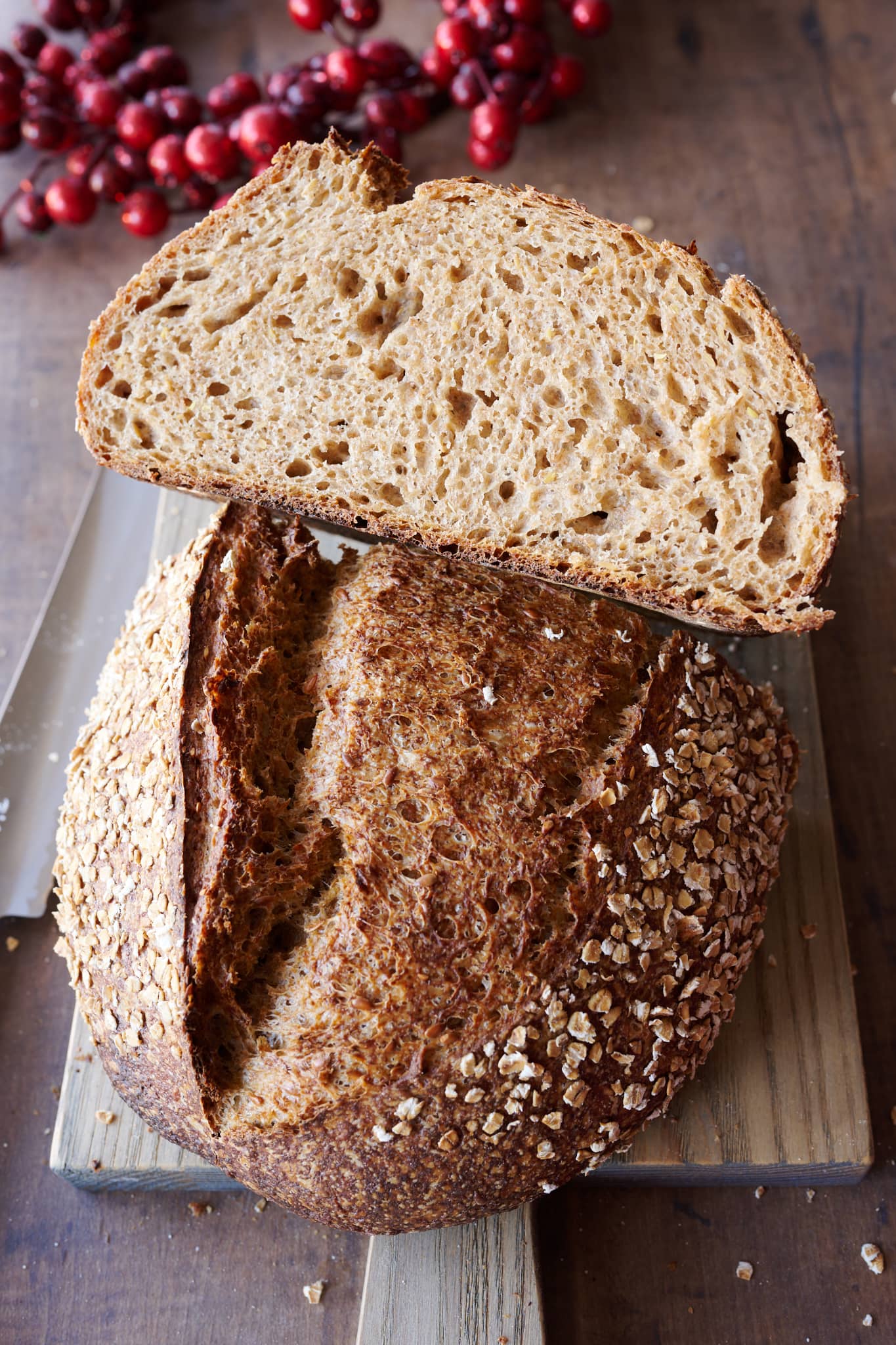
What Is Kernza?
Kernza is a perennial wheatgrass with exceptionally long roots that extend deep into the soil, making it beneficial for ecological farming. Long roots help improve the soil’s health, and because it’s a perennial plant, it grows back each year without replanting. It can be used in bread, brewing, and other baked goods like crackers, cookies, and muffins.
Kernza has a decidedly nutty and sweet flavor and works well in sourdough bread and other baked goods. For bread specifically, generally, you can easily use it instead of wheat flour for up to 20 to 30% of the total flour.
Be sure to read through the Bread Baker’s Guide to Kernza for more information on this delicious and revolutionary grain.
Flour and Seed Selection
Sourcing Kernza
You can find whole-grain Kernza online at Perennial Pantry, which also offers whole and sifted (white) Kernza flour. Additionally, Breadtopia has whole-grain Kernza available.
How To Freshly Mill Kernza
I had trouble milling Kernza with my KoMo Classic grain mill. Kernza kernels are long and slender compared to most varieties of wheat, which are shorter and fatter. While the KoMo had trouble, the MockMill 100 home grain mill milled the Kernza without issue and quite finely at that.
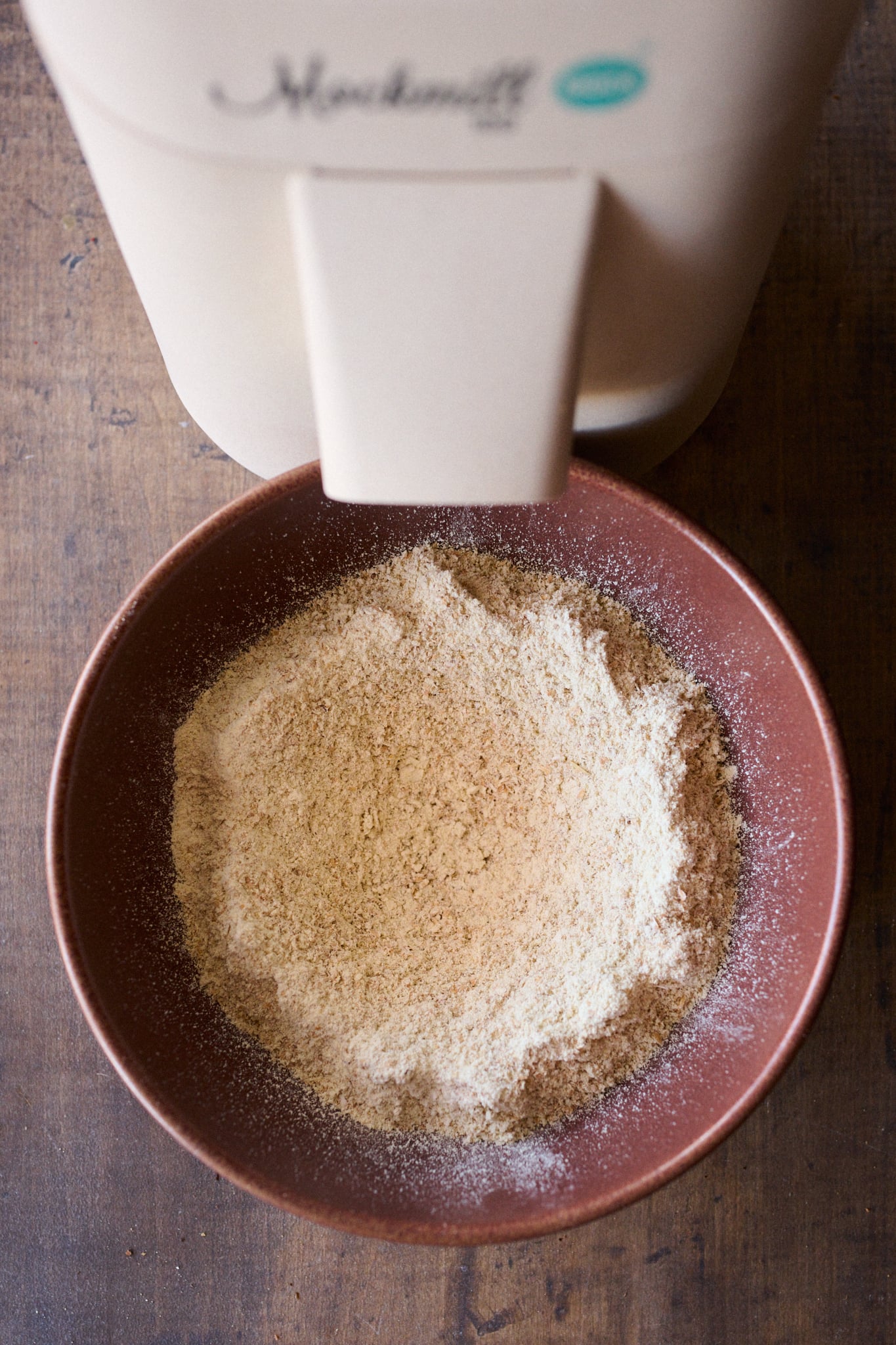
Load the hopper of your grain mill with 10 to 20g more Kernza than called for in the recipe, set it to the finest mill setting, and mill until all the flour is produced. I like to mill the Kernza first thing in the morning and let it sit on the counter so it comes to room temperature before the autolyse.
See my guide to milling fresh flour at home for tips on keeping the flour cool and the best way to set up your grain mill.
Golden Flaxseed
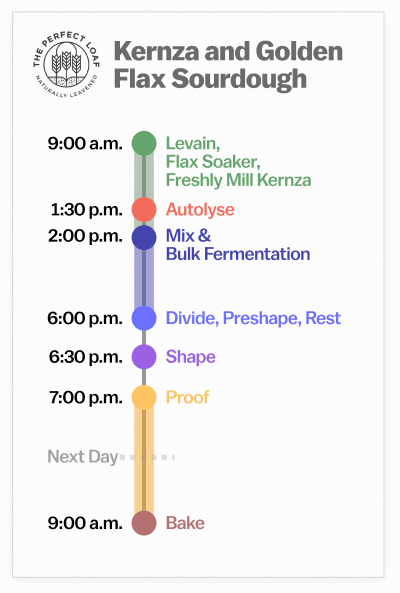
You can use brown or golden flaxseed for this Kernza sourdough bread, though I always choose the golden variety because of its striking yellow color. My favorite Is Bob’s Red Mill Organic Whole Golden Flaxseed.
If you don’t have flaxseed or do not like it, feel free to substitute it for white or black sesame seeds.
Baking Schedule
This Kernza sourdough bread is made over two days for increased flavor and a convenient baking schedule. But it’s also possible to make it in a single day by allowing the dough to proof on the counter, shaped and covered until the dough is puffy, relaxed, and passes the dough poke test (about 2 to 4 hours, temperature depending).
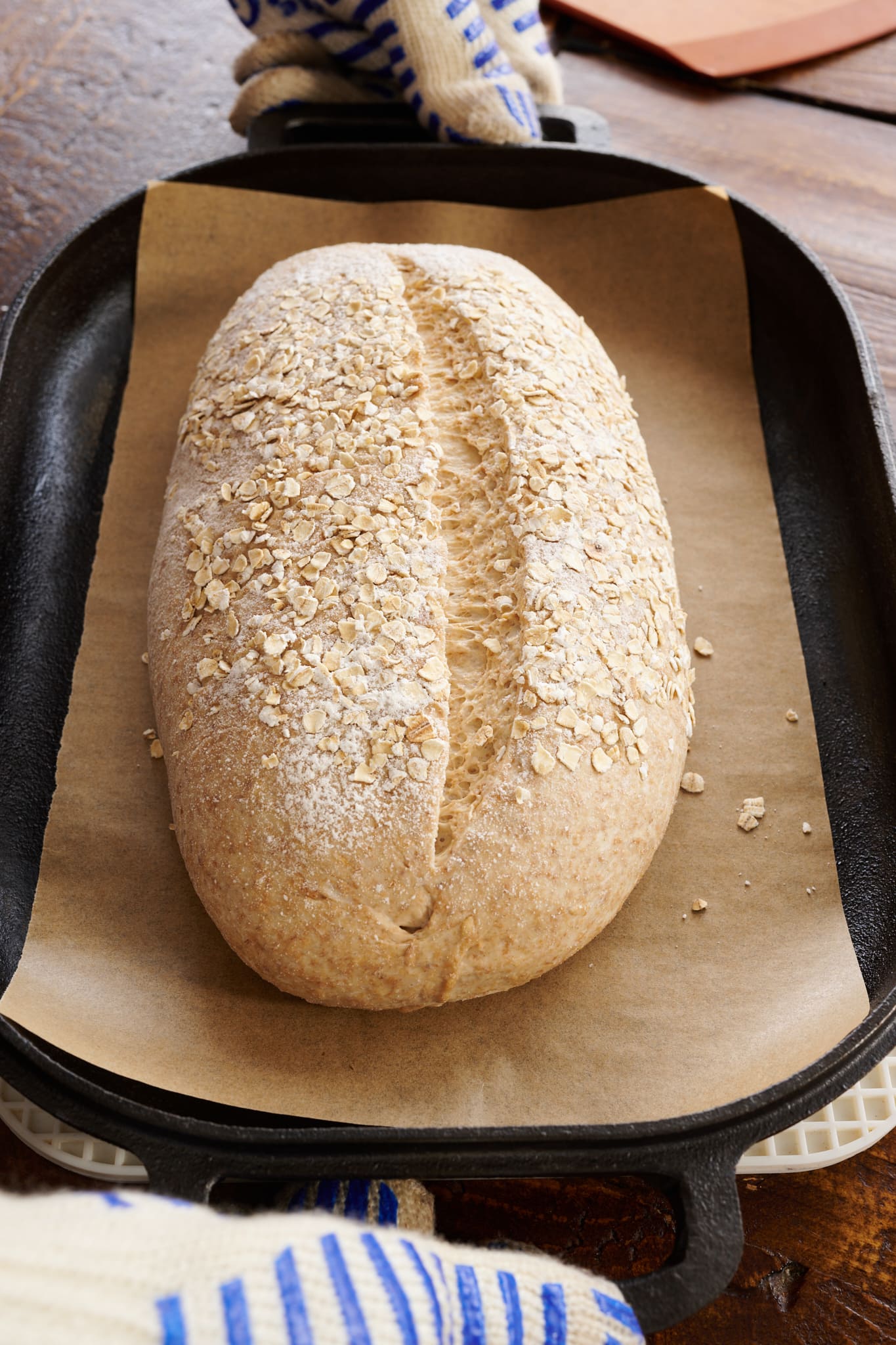
Kernza Sourdough Bread Recipe
For tips on calculating baker’s percentages or modifying this formula, see my post on baker’s percentages (baker’s math).
Vitals
| Total dough weight | 1,800 grams |
| Prefermented flour | 7.3% |
| Levain in final dough | 19.5% |
| Hydration | 81.0% |
| Yield | Two 900g loaves |
Total Formula
Desired dough temperature: 78°F (25°C) (see my post on the importance of dough temperature).
| Weight | Ingredient | Baker’s Percentage |
|---|---|---|
| 512g | Medium-protein bread flour (about 11.5% protein; Central Milling Artisan Baker’s Craft) | 55.0% |
| 279g | Freshly milled Kernza flour | 30.0% |
| 140g | Whole wheat flour (Cairnspring Whole Grain Expresso) | 15.0% |
| 65g | Golden flaxseed | 7.0% |
| 707g | Water 1 (levain, soaker, and autolyse) | 76.0% |
| 47g | Water 2 (mix) | 5.0% |
| 17g | Fine sea salt | 1.8% |
| 34g | Ripe sourdough starter, 100% hydration | 3.6% |
Additional Ingredients
About ½ cup of rolled oats, for topping (optional)
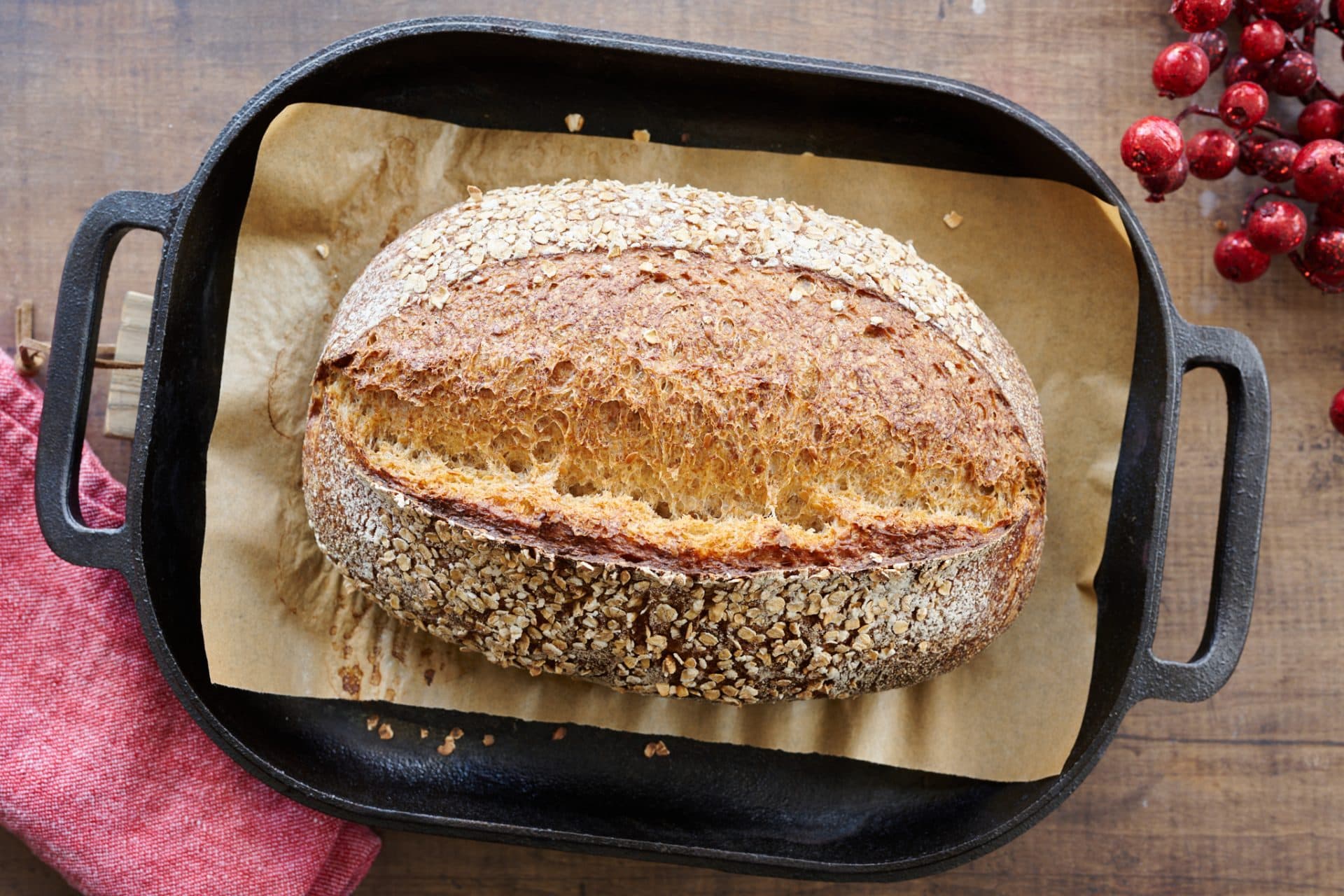
Kernza Sourdough Bread Method
1. Prepare the levain – 9:00 a.m.
| Weight | Ingredient | Baker’s percentage |
| 34g | White flour (about 11.5% protein; Central Milling Artisan Baker’s Craft) | 50.0% |
| 34g | Whole wheat flour (Cairnspring Whole Grain Expresso) | 50.0% |
| 68g | Water 1 (levain) | 100.0% |
| 34g | Ripe sourdough starter, 100% hydration | 50.0% |
Mix the ingredients in the chart above in a jar (these are my favorite jars for a levain or even your starter) and leave them covered at a warm temperature, 74-76°F (23-24°C), to ripen for 5 hours.
2. Prepare the seed soaker and freshly mill Kernza – 9:10 a.m.
| Weight | Ingredient | Baker’s percentage |
| 65g | Golden flaxseed | 100.0% |
| 75g | Water 1 (soaker) | 115.0% |
Mix the soaker ingredients in the above chart in a jar and cover them while the levain ripens. Try to submerge all the seeds in water as best you can.
Using a home grain mill, freshly mill 279 grams of Kernza flour. Keep the flour on the counter after milling until called for in the autolyse.
3. Autolyse – 1:30 p.m.
| Weight | Ingredient |
| 478g | White flour |
| 279g | Freshly milled Kernza flour |
| 106g | Whole wheat flour |
| 565g | Water 1 (autolyse) |
I use the autolyse technique for this recipe to help reduce the total mixing time required, but I also find it helps aid in the dough’s extensibility.
Warm or cool the autolyse water so that the temperature of the mixed dough meets the final dough temperature (FDT) of 78°F (25°C) for this recipe. Place the flour and remaining water 1 (autolyse) in a large bowl. Use wet hands to mix until no dry bits remain; the dough will be shaggy and loose. Use a bowl scraper to scrape down the sides of the bowl to keep all the dough in one area at the bottom. Cover the bowl and place it near your levain for 30 minutes.
4. Mix – 2:00 p.m.
| Weight | Ingredient |
| 140g | Golden flaxseed soaker |
| 47g | Water 2 (mix) |
| 17g | Fine sea salt |
| 168g | Ripe levain (from Step 1) |
Add the salt and levain to the top of the dough in autolyse and use a splash of water 2 to moisten. With wet hands, mix thoroughly. Kernza can feel a little sticky when mixing, which is normal. Use wet hands or a dough whisk to help make mixing easier. Add the remaining water 2 if the dough feels like it can handle it.
Next, knead the dough for a few minutes using either the slap and fold technique or folds in the bowl. For this dough, I kneaded for about 5 minutes until the dough smoothed and became elastic. Transfer the dough back into the bowl.
With moistened hands, spread the flaxseed soaker over the top and pinch it into the dough. Fold the dough over itself and continue pinching until all of the seeds are mixed thoroughly. Transfer the dough to a bulk fermentation container and cover.
5. Bulk Fermentation – 2:30 p.m. to 6:00 p.m. (3 hours 30 minutes)
At a warm room temperature, 74-76°F (23-24°C), bulk fermentation should take about 3 hours and 30 minutes.
This dough will require 3 sets of stretches and folds during bulk fermentation. After the first 30 minutes, wet your hands, grab the side of the dough farthest from you, and stretch it over to the other side. Rotate the bowl 180 degrees and repeat. Then rotate the bowl a quarter turn and stretch and fold that side. Rotate the bowl 180 degrees again and finish with a stretch and fold on the last side. The dough should be neatly folded up in the bowl. Cover and repeat these folds every 30 minutes for 3 sets of stretches and folds. Then let the dough rest, covered, for the remainder of bulk fermentation.
Read through my guide to the bulk fermentation step for more information on why this step is such an important part of the sourdough bread-making process.
6. Divide and Preshape – 6:00 p.m.
After 3 hours and 30 minutes, the dough should be well-risen and puffy in the bulk fermentation container. Because of the high percentage of freshly milled flour and whole grains, the dough may not rise as high as a recipe with more white flour. It will be ready to divide when the top of the dough is smooth, bubbly, and the edge where the dough meets the container is slightly domed downward.
Fill a small bowl with water and place it next to your work surface. Scrape the dough onto a clean counter and divide it into two equal pieces. With one wet hand and a bench knife in the other, preshape the pieces of dough into loose rounds.
Let the dough rest, uncovered, for 30 minutes.
7. Shape – 6:30 p.m.
Place a baking sheet or clean kitchen towel next to your work surface and, if using, spread an even layer of white rolled oats on top.
Flour the top of the preshaped round and your work surface. Using your bench knife, flip one of the rounds over onto the floured area. Using floured hands, shape the dough into a bâtard. Transfer the shaped dough, seam-side up, to the pan with oats and rock it back and forth so the oats stick. See my guide to topping bread dough for more help on getting the oats to stick to the dough.
Gently transfer the dough to an 11-inch long proofing basket, seam-side up. Repeat with the remaining round.
8. Proof – 7:00 p.m. to 9:00 a.m.
Cover the baskets with a large, reusable plastic bag and seal shut. Place the baskets in the refrigerator to proof overnight.
9. Bake – 9:00 a.m.
Due to the oval shape of these loaves, you can bake them in a Challenger baking pan as I’ve done here or directly on a baking surface, steaming your oven.
Place an oven rack with an oval Dutch oven in the bottom-third of the oven. Preheat the oven to 450°F (230°C) for 30 minutes.
See my guide to steaming a home oven for bread baking for instructions on baking without a Dutch oven.
Uncover one of the proofing baskets out of the fridge, and put a piece of parchment paper over it. Place a pizza peel or inverted baking sheet on top of the parchment, and using both hands, flip everything over. Gently remove the basket and score the dough.
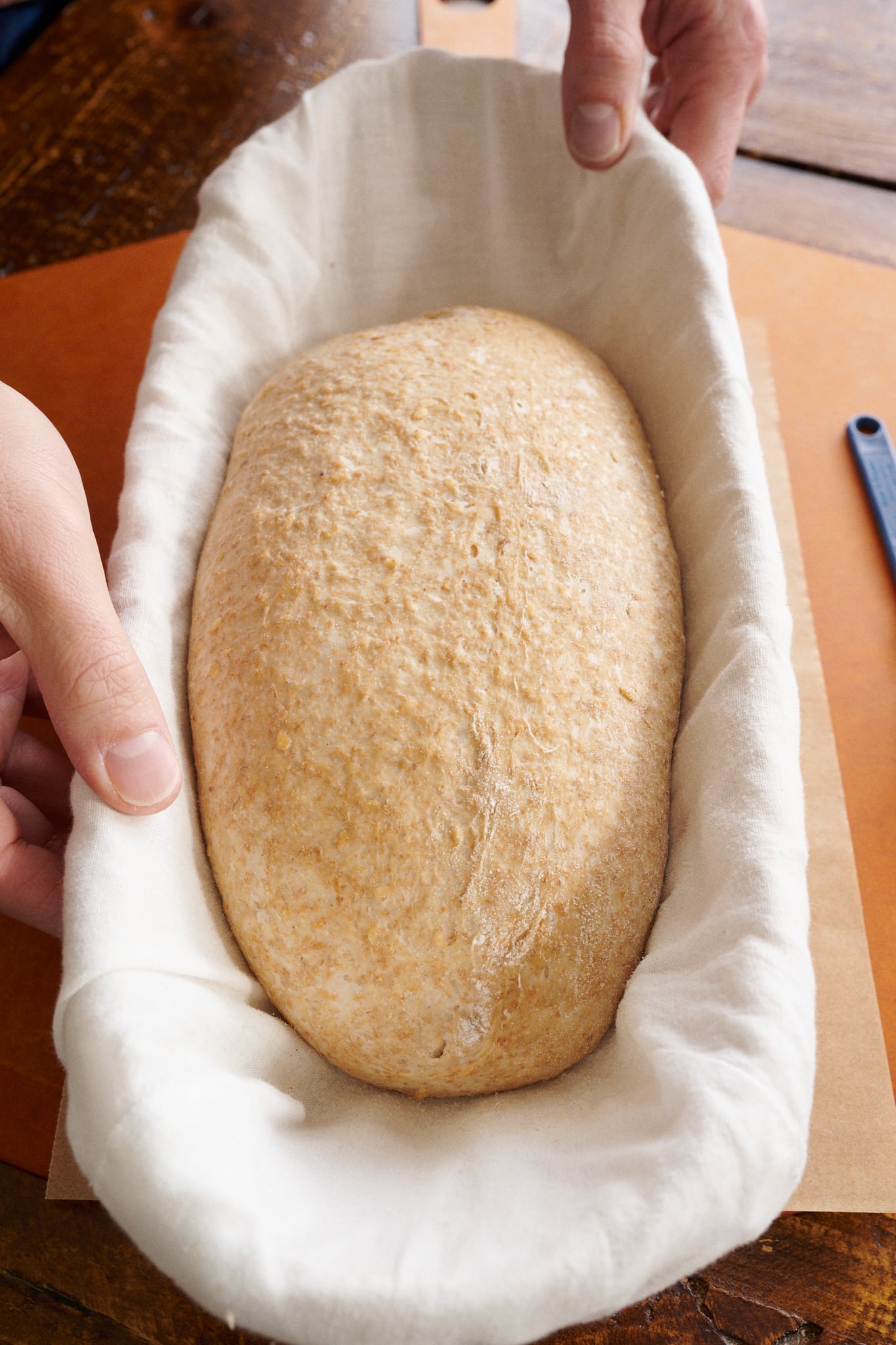
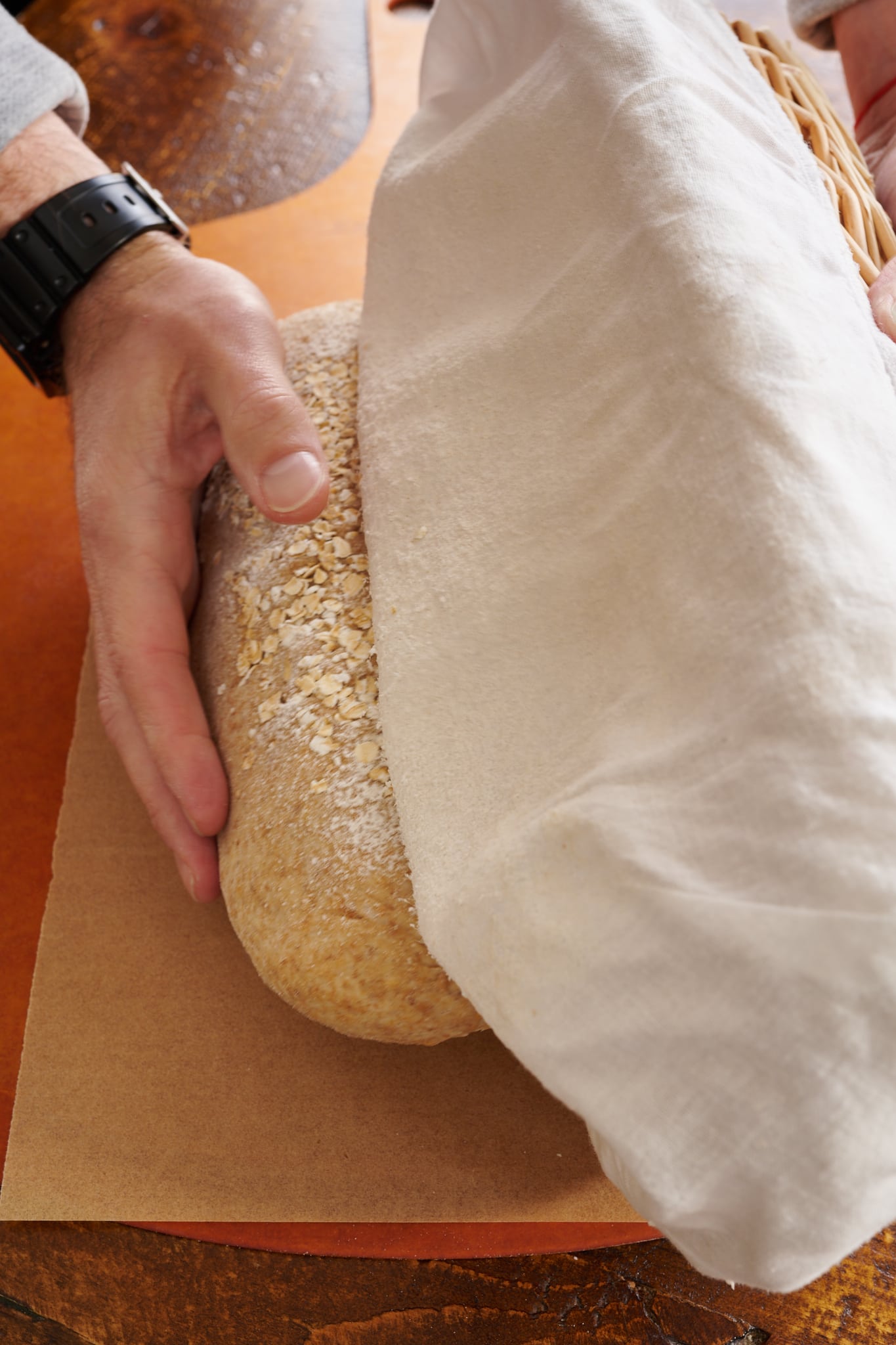
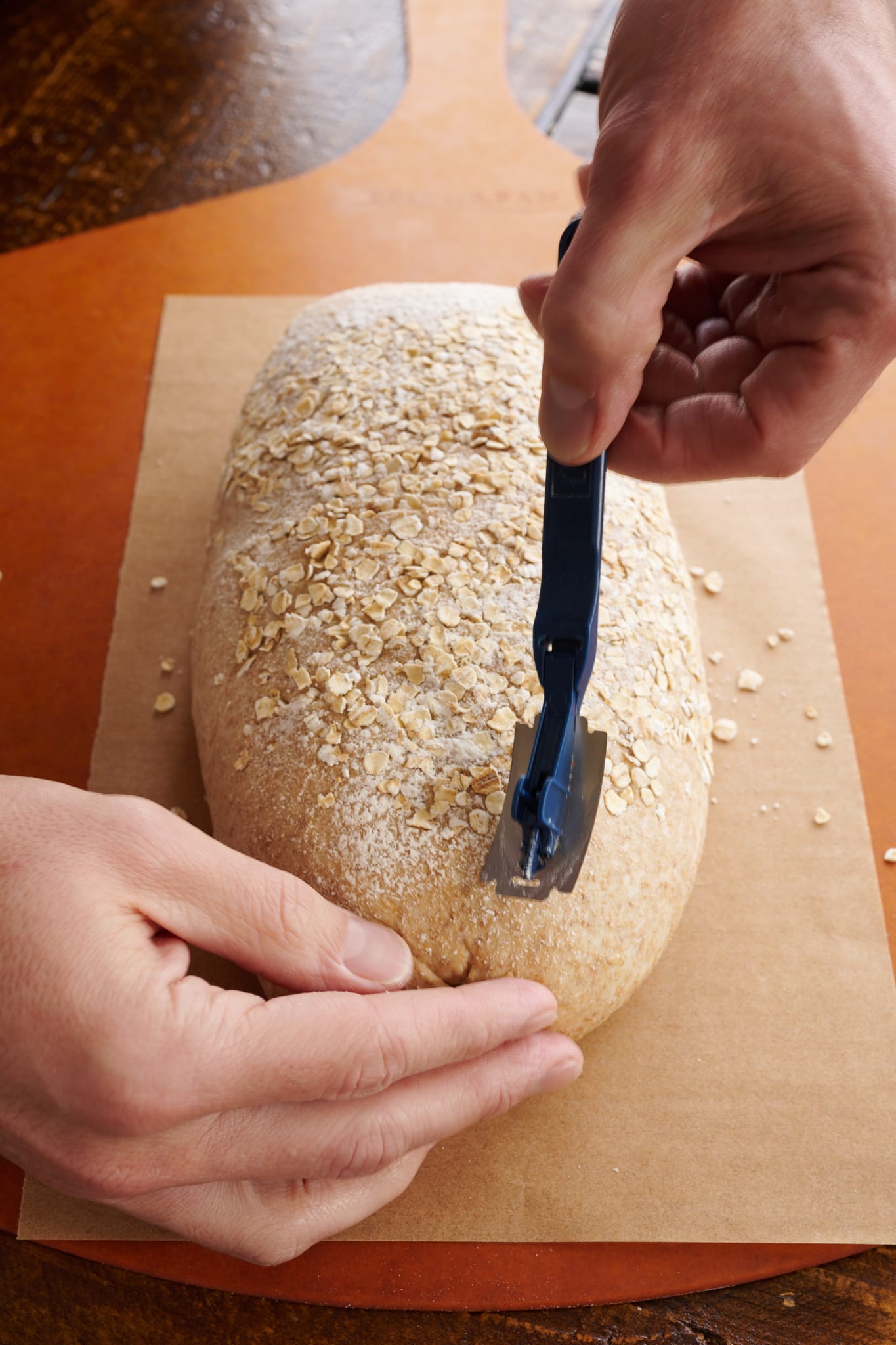
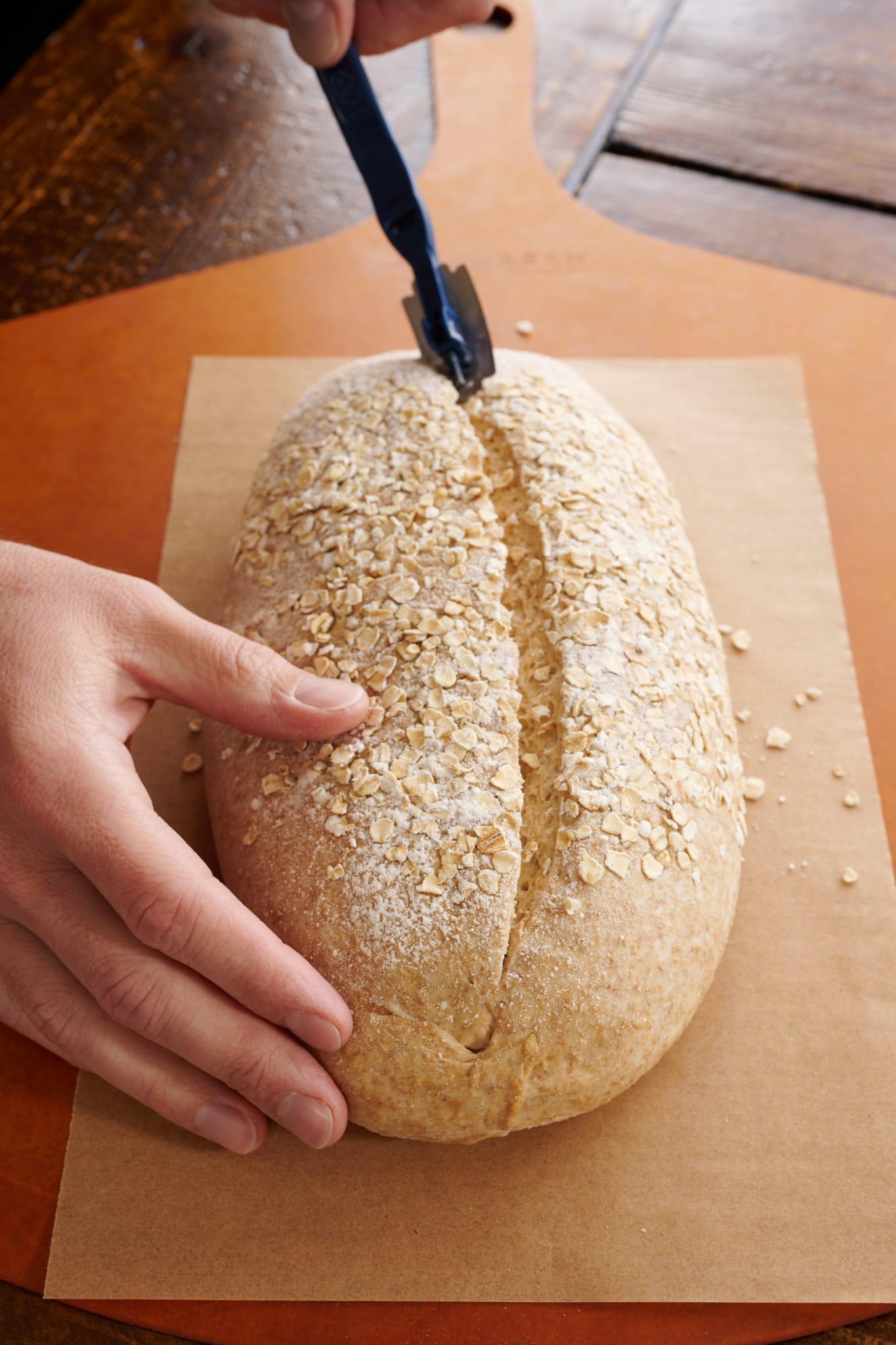
Remove the bottom of the preheated Dutch oven and slide the dough into the pan. Return the pan to the oven and cover with the lid. Bake for 20 minutes. Vent the pan of steam by uncovering the pan (remove the lid from the oven or place it on the rack next to the bottom of the Dutch oven). Continue to bake for 35 minutes more. When done, the loaf should have an internal temperature of around 204°F (95°C), and the crust should be deeply colored.
Carefully remove the loaf from the Dutch oven to cool on a wire rack. Return the Dutch oven lid and bottom to the oven to preheat for 15 minutes. Repeat with the remaining dough in the refrigerator.
Let the loaves cool on a wire rack for 2 hours before slicing with your favorite bread knife.
Print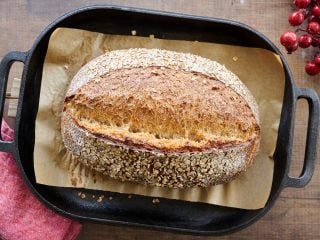
Kernza Sourdough Bread Recipe
- Author: Maurizio Leo
- Prep Time: 24 hours
- Cook Time: 55 minutes
- Total Time: 24 hours 55 minutes
- Yield: 2 loaves
- Category: Lunch, Dinner
- Cuisine: American
Description
Sourdough bread with freshly milled Kernza flour, a sustainable perennial wheatgrass that’s as delicious as it is nutritious.
Ingredients
Levain
- 34g White flour (about 11.5% protein; Central Milling Artisan Baker’s Craft)
- 34g Whole wheat flour (Cairnspring Whole Grain Expresso)
- 68g Water
- 34g Ripe sourdough starter, 100% hydration
Golden Flaxseed Soaker
- 65g Golden flaxseed
- 75g Water
Autolyse
- 478g White flour
- 279g Freshly milled Kernza flour
- 106g Whole wheat flour
- 565g Water
Main Dough
- All of the golden flaxseed soaker
- 47g Water
- 17g Fine sea salt
- All of the ripe levain
Instructions
- Levain (night before mixing, 9:00 p.m.)
In a small container, mix the Levain ingredients and keep it at a warm temperature for 5 hours. - Prepare soaker and mill Kernza (9:10 a.m.)
Mix the soaker ingredients in the above chart in a jar and cover them while the levain ripens. Try to submerge all the seeds in water as best you can. Using a home grain mill, freshly mill 279 grams of Kernza flour. Keep the flour on the counter after milling until called for in the autolyse. - Autolyse (1:30 p.m)
In a medium mixing bowl, add the Autolyse ingredients and mix until no dry bits remain. Cover the bowl and let rest for 30 minutes. - Mix (2:00 p.m.)
Add the salt and levain to the top of the dough in autolyse and use a splash of water to moisten. With wet hands, mix thoroughly. Add the remaining water if the dough feels like it can handle it. Next, knead the dough for about 5 minutes until the dough smoothed and became elastic. With moistened hands, spread the flaxseed soaker over the top and pinch it into the dough. Fold the dough over itself and continue pinching until all of the seeds are mixed thoroughly. Transfer the dough to a bulk fermentation container and cover. - Bulk Fermentation (2:30 a.m. to 6:00 p.m.)
Perform 3 sets of gentle stretch and folds during this 3 and 1/2-hour period, then let the dough rest for the remainder of bulk fermentation. - Divide and Preshape (6:00 p.m.)
Lightly flour your work surface and scrape out your dough. Using your bench knife, divide the dough in half. Lightly shape each half into a round shape. Let the dough rest for 30 minutes, uncovered. - Shape (6:30 p.m.)
Shape the dough into a round (boule) or oval (batard) and place in proofing baskets. Cover the baskets with a reusable plastic bag. - Proof (7:00 p.m. to 9:00 a.m. the next day)
Cover proofing baskets with reusable plastic and seal shut. Then, place both baskets into the refrigerator and proof overnight. - Bake (The next day, bake at 9:00 a.m.)
Preheat your oven with a baking surface or combo cooker/Dutch oven inside to 450°F (230°C). When the oven is preheated, remove your dough from the fridge, score it, and transfer to the preheated baking surface or combo cooker. Bake for 20 minutes with steam. After this time, vent the steam in the oven or remove the lid (you can keep it in the oven or remove it) and continue to bake for 35 minutes longer. When done, the internal temperature should be around 204°F (95°C). Repeat for the second loaf.Let the loaves cool for 2 hours on a wire rack before slicing.
Notes
Golden flaxseed can be substituted for brown flaxseed or sesame seeds.
Kernza Sourdough Bread FAQs
Can I use brown flaxseed in this Kernza Sourdough Bread recipe?
Yes, both golden and brown flaxseed will work equally well with this Kernza sourdough bread recipe.
Can this bread recipe be made with sifted (white) Kernza flour?
Yes, but reduce the dough’s hydration by 5% (to total flour).
What’s Next?
After baking and tasting this freshly milled Kernza sourdough bread, I can completely understand why Kernza has seen such a surge in popularity. The grain is not only good for our planet, but it’s also delicious on the dinner table.
If you’re keen on working with more freshly milled flour, see the guide to milling flour at home or try sourdough bread with freshly milled Yecora Rojo whole wheat.
Buon appetito!


